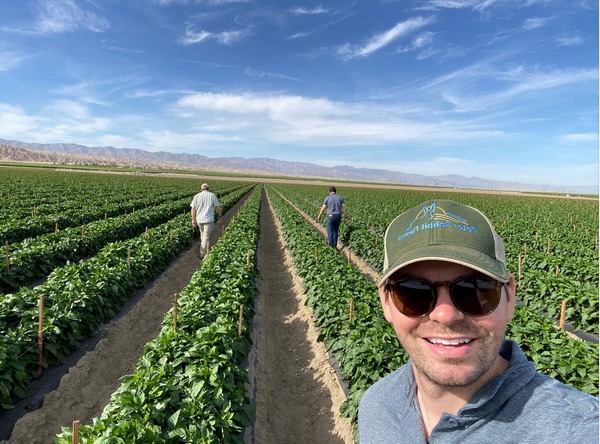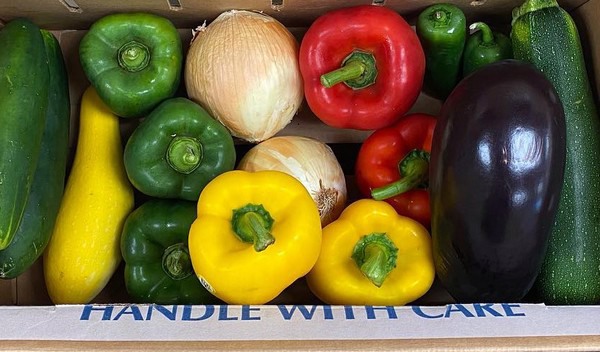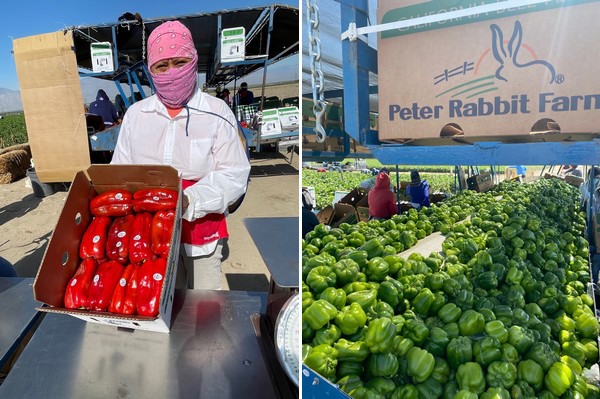Weather challenges, limited pallets and high freight rates have collectively made for a higher than normal pepper market.
In the West, production is currently out of Coachella, CA. “We’re seeing a healthy supply of red bell peppers here. Our green bell peppers will have a few more weeks here and then in two to three weeks, we’ll switch to Bakersfield with a company called Johnston Farms,” says Garret Powell of Peter Rabbit Farms in Coachella. It’s Peter Rabbit’s first year with Johnston and it allows Peter Rabbit to have volume on green bell peppers through mid-July.
 Garret Powell along with dad Steve Powell, COO and brother Collin Powell, field manager of Peter Rabbit Farms walk the fields before green bell harvest at the beginning of April. Photo: Peter Rabbit Farms.
Garret Powell along with dad Steve Powell, COO and brother Collin Powell, field manager of Peter Rabbit Farms walk the fields before green bell harvest at the beginning of April. Photo: Peter Rabbit Farms.
That said, overall production has been down out of Coachella. Challenging the crop were high winds at the start of the season which led to slower harvesting initially, as well as warm temperatures. (There are also some reports of California growers who lost peppers due to bloom drop and the heat.) “But we’re catching up and starting on our last block,” says Powell.
Competing with Coachella product is also Mexican product coming out of Nogales, AZ.
East Coast limited too
In the East, Florida also had limited production thanks to weather conditions and less acreage--the state continues to lose agriculture acreage to housing development. And in Georgia, which is in production now, it’s also had weather conditions to contend with including extremely heavy rain, winds and some hail damage early on in the crop. “That caused some early plantings to be lost. Those transplants that were damaged were either not replaced or planted late due to limited availability of plants out of the greenhouses. It looks like the later plantings are coming on now says Neil Mazal of East Coast Farms & Vegetables in Lake Worth, FL. And around the corner, South and North Carolina also have limited production available since it’s in the early start of its season.
 Neil Mazal of East Coast Farms said Florida also had limited production of peppers this year thanks to weather conditions and less acreage. Photo: East Coast Farms & Vegetables.
Neil Mazal of East Coast Farms said Florida also had limited production of peppers this year thanks to weather conditions and less acreage. Photo: East Coast Farms & Vegetables.
Meanwhile overall demand is, not surprisingly, strong on bell peppers. “It’s strong on both green and reds,” says Powell. “With everything opening back up, we’re seeing a bit more foodservice business too. Bell peppers are something people love to cook with.”
Making for strong pricing
What is also not surprising is that pricing is strong on peppers too. “On the extra large and large sizes it’s relatively similar in pricing to last year. But on greens, the choice market has lagged behind compared to last year,” says Powell. “This year there’s more of a gap between #1 peppers and choice.”
However there are challenges in dealing with peppers, some of which are factoring into that pricing starting with water supply in California. “A lot of row crop or dry vegetable farmers have diverted water supply to their high-production crops such as almonds and other deciduous tree crops,” says Mazal. “So there’s a poorer supply of water for dry vegetables growing.”
 Demand for bell peppers has been strong and with the reopening of restaurants, foodservice demand for peppers is growing again as well. Photo: Peter Rabbit Farms.
Demand for bell peppers has been strong and with the reopening of restaurants, foodservice demand for peppers is growing again as well. Photo: Peter Rabbit Farms.
High freight rates also continue to be a factor, particularly for West Coast growers shipping to the population-dense Northeast. “Shipping something like peppers could compete against loads of cherries, peaches, grapes and plums which are high-dollar cargo,” says Mazal. “A load of cherries could be worth $80,000-$90,000 and somebody getting quoted $15,000 for a truck probably won’t blink an eye. Someone with a load of peppers maybe worth $15,000 may not want to pay $10,000-$12,000 for a truck.”
And of course coast to coast, the lack of pallet availability thanks to an overall shortage of wood also continues affecting growers and shippers and some are saying they can’t find enough pallets to ship product on.
 For more information:
For more information:
Garret Powell
Peter Rabbit Farms
Tel: +1 (760) 398-0136
[email protected]
https://www.peterrabbitfarms.com/
 Neil Mazal
Neil Mazal
East Coast Farms & Vegetables
Tel: +1 (561) 951-0876
[email protected]
https://www.eastcoastfarms.us/










